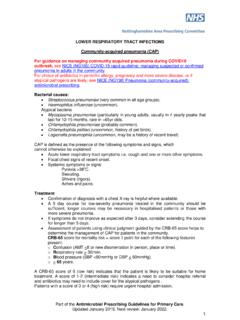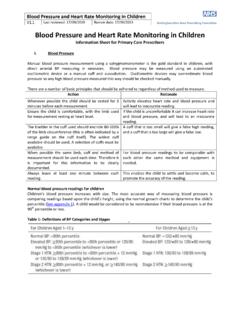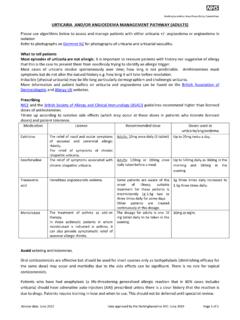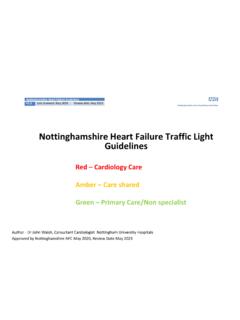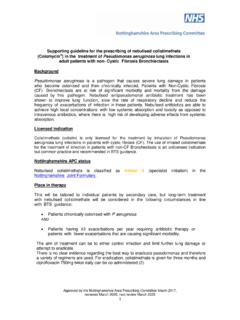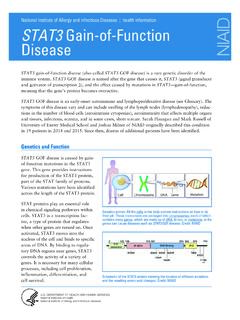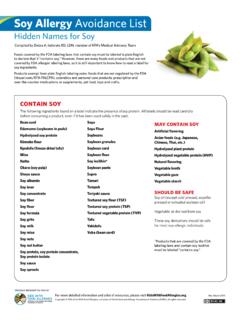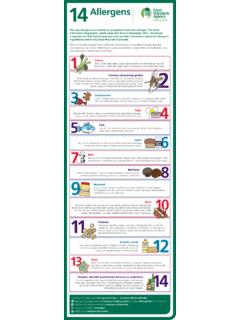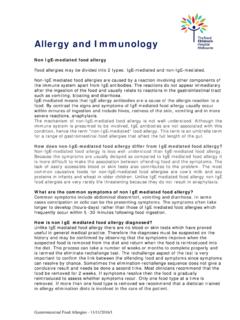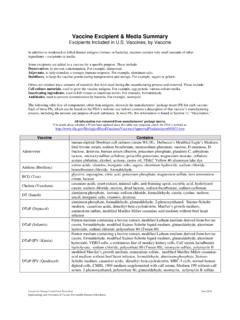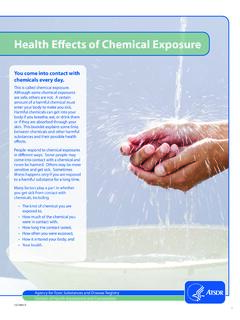Transcription of Vitamin D Management in Children - NottsAPC
1 Vitamin D Management in Children Last reviewed: 25/02/2021 Review date: 25/02/2024 Vitamin D Management in Children Page 1 of 10 Vitamin D deficiency is common and its Management can be an area of confusion owing to lack of high quality evidence for Children . The Royal College of Paediatrics and Child Health issued interim practical consensus guidance in October 2013 regarding suggested definition, prevention, investigation and Management of Vitamin D deficiency. This guideline is based on their recommendations alongside local recommendations regarding specific Management options (see separate secondary care guidance). It has been updated in 2016 to reflect the current recommended Vitamin D preparations for each dosing strategy. See also the Guide for Vitamin D in Childhood, October 2013, RCPCH ( ) for further information.
2 Note there is separate guidance regarding Vitamin D targets and supplementation for certain patient groups, cystic fibrosis and chronic renal disease. Please consult the relevant specialist guidelines for these patients. Lifestyle advice for all - see appendix 2 Safe sun and dietary advice Routine Vitamin D level testing of asymptomatic patients is not recommended, but address lifestyle factors and assess the need for prevention dose supplements. Investigate if symptomatic (see appendix 1 for risk factors and symptoms / signs). Children with chronic illness including renal/liver disease, malabsorption will require monitoring of Vitamin D levels as per their own specialist guidance. < 25 nmol/L Measure: 25OH Vitamin D (2ml in yellow top bottles) Bone profile (Ca, PO4, Alk phos) PTH (if hypocalcaemic or rickets) X-ray wrist/knee if concerns re rickets (see appendix 1) > 50 nmol/L 25-50 nmol/L Is the patient symptomatic?
3 See appendix 1 Reinforce safe sun and dietary advice Prevention / maintenance dose supplements (purchased OTC) advised for the following groups of patients: breastfed babies from birth to 1 yr. formula-fed babies having less than 500ml of infant formula a day. Children aged 1-4 years old should be given a daily supplement. Children who have had treatment for Vitamin D deficiency and symptoms these Children need long-term prevention supplements. Children in at risk group see appendix 1. See appendix 3 for doses. Supplements to be purchased OTC. Prescribe only in exceptional cases if self-care not appropriate see appendix 3. Refer to secondary care if the patient has any of the following: Symptomatic Vitamin D deficiency clinical evidence of rickets symptomatic of hypocalcaemia or bone disease (same day referral needed) Treatment failure due to absorption or compliance issues (this could be via a phone call discussion or advice and guidance request) There is a paediatric endocrinologist available for advice to healthcare professionals across the East Midlands 24 hours a day; contact via QMC switchboard on 0115 924 9924.
4 Prescribe TREATMENT DOSE for 7 weeks see appendix 4 Recheck Vitamin D and bone profile to ensure normal at end of treatment course: If not normal: check compliance, consider malabsorption or genetic rickets discuss with Paediatric Endocrinology. If normal, continue long term prevention dose (purchased OTC) . Prescribe only in exceptional cases if self care not appropriate see appendix 3. Screen +/- treat other family members YES Referral not needed NO Vitamin D Management in Children Last reviewed: 25/02/2021 Review date: 25/02/2024 Vitamin D Management in Children Page 2 of 10 Appendix 1: Risk factors and symptoms / signs of deficiency Routine Vitamin D level testing of asymptomatic patients is not recommended, but address lifestyle factors and assess the need for prevention dose supplements (appendix 2).
5 Investigate if symptomatic as per flowchart on page 1. Children with chronic illness including renal/liver disease, malabsorption will require monitoring of Vitamin D levels as per their own specialist guidance. Table 1: Risk factors for Vitamin D deficiency Inadequate UVB light exposure Inadequate dietary intake or absorption Metabolic factors Pigmented skin (non-white ethnicity) Lack of sunlight exposure or atmospheric pollution Skin concealing garments or routine use of sun protection factor 15 or above Housebound or indoor living ( care homes) Seasonal Vegetarian (or other fish-free diet) Prolonged breastfeeding, even if mother has sufficient Vitamin D Exclusion diets milk allergy Malabsorption ( coeliac disease, Crohn s disease etc.) Short bowel Cholestatic liver disease, jaundice Children and young people with family members with proven Vitamin D deficiency Drug interactions rifampicin, anticonvulsants (carbamazepine, oxcarbazepine, phenobarbital, phenytoin, primidone and valproate), isoniazid, cholestyramine, sucralfate, glucocorticoids, highly active antiretroviral treatment (HAART) Chronic liver disease Chronic renal disease Symptoms / signs of Vitamin D deficiency Hypocalcaemic seizures (usually in infancy) Tetany due to low serum calcium Cardiomyopathy Aches and pains long-standing (>3 months), unexplained bone pain muscular weakness ( difficulty climbing stairs, waddling gait, difficulty rising from a chair or delayed walking) Rickets.
6 Swollen ankles/wrists, rachitic rosary (swelling of the costochondral junctions), progressive bowing of legs, progressive knock knees, craniotabes (skull softening with frontal bossing and delayed fontanelle closure), delayed tooth eruption and enamel hypoplasia. Incidental investigation finding (osteopenia, low serum calcium or phosphate, high Alk Phos) Vitamin D Management in Children Last reviewed: 25/02/2021 Review date: 25/02/2024 Vitamin D Management in Children Page 3 of 10 Appendix 2: Patient information about Vitamin D and lifestyle advice Link to printable local patient information leaflet: Notts APC website / Patient Info / Vitamin D - Patient information leaflet Lifestyle advice Advice for Children under 5 years: The Department of Health recommends that: breastfed babies from birth to one year of age should be given a daily Vitamin D supplement to make sure they get enough.
7 Formula-fed babies should not be given a Vitamin D supplement until they are having less than 500ml (about a pint) of infant formula a day, as infant formula is fortified with Vitamin D Children aged 1-4 years old should be given a daily supplement containing 400 units (10micrograms) of Vitamin D You can buy Vitamin D supplements or Vitamin drops containing Vitamin D (for under-fives) at most pharmacies and supermarkets. See appendix 3 for recommended prevention / maintenance doses. Advice for Children and young people over 5 years: Public Health England suggest that people should consider taking a daily supplement containing 400 units (10 micrograms) of Vitamin D during autumn and winter when there is limited sun exposure. All year round supplements should be considered for people, who have very little or no sunshine exposure housebound, in a residential home, usually wear clothes that cover up most of the skin.
8 Patients should be advised to purchase over the counter. See appendix 3 for recommended prevention / maintenance doses. Safe Sun (provides 85-90% of our Vitamin D) Recommended short periods outside around midday in the UK between May-September, exposing minimum of face/hands/forearms WITHOUT sunscreen. The time should be less than the time taken to redden or burn (in Caucasian Children approx. 10 minutes but the exact time will depend on skin pigmentation, pollution, age). If Children have sun-sensitive conditions or are using medication which may predispose this, exposure should be restricted as per dermatologist advice. Between October and early March we do not get enough Vitamin D from sunlight and it is difficult to get the recommended daily intake from diet alone.
9 See NHS website for more information on how to get Vitamin D from sunlight. Diet (only 10-15%) Vitamin D can be found in a small number of foods including: Egg yolks Formula milk Fortified foods such as most fat spreads, soy yogurts, soy milk, almond milk, some orange juices and some breakfast cereals Liver Mushrooms Oily fish such as salmon, sardines, herring and mackerel* Red meat Ricotta Cheese *note that tuna (fresh or canned) does not count as oily fish (NHS website) Dairy products are not routinely fortified so are not sources of Vitamin D but are good sources of calcium. More information for patients is available on the following websites: NHS Website Vitamin D National Osteoporosis Society: A balanced diet for bones Royal National Orthopaedic Hospital: FAQs about Vitamin D in childhood Royal College Obstetrics and Gynaecologists: Healthy eating and Vitamin supplements in pregnancy BDA food fact sheet on Vitamin D Vitamin D Management in Children Last reviewed: 25/02/2021 Review date: 25/02/2024 Vitamin D Management in Children Page 4 of 10 Appendix 3: Prevention / maintenance supplements Prevention / maintenance doses: Newborn up to 1 month: 300 - 400 units daily (equivalent to 10 micrograms) 1 month to 12 years.
10 400 - 800 units daily (equivalent to 10 20 micrograms) 300 units ( ) daily if using Healthy Start Vitamin Drops Patients should buy Vitamin D supplements unless they meet one of the specific Vitamin D exception criteria in the NHS England guideline: summarised in local Vitamin D position statement and full guidance on page 16 of conditions for which over the counter items should not routinely be prescribed in primary care. Note that the need for maintenance or preventative treatment is not an exception for Vitamin D self-care. Exceptions to self-care are also listed in the Nottingham & Nottinghamshire CCG Vitamin D position statement. Prescriptions for Vitamin D should be reserved for the treatment of patients with symptoms of deficiency or confirmed deficient Vitamin D levels that require treatment with loading doses.
